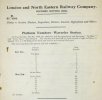ctom_s
Member
Generally, if you're standing at a *Terminus* facing the platforms from the concourse platform 1 is on your left and the highest numbered platform is on your right.
First question is why are the Fenchurch Street platforms numbered in reverse then?
Second question is are there many other examples of terminuses with this reverse numbering people can think of, I can't think of any others in London...
First question is why are the Fenchurch Street platforms numbered in reverse then?
Second question is are there many other examples of terminuses with this reverse numbering people can think of, I can't think of any others in London...

